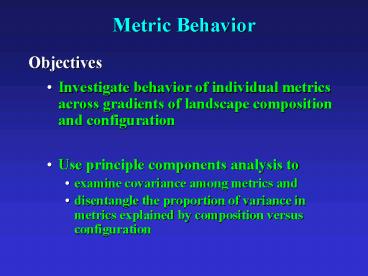Metric Behavior - PowerPoint PPT Presentation
1 / 26
Title:
Metric Behavior
Description:
Factorial Design. H (n = 21) x P (n = 19) 100 replicates of each of 399 H x P ... Compare sensitivity of different metrics to changes in landscape structure ... – PowerPoint PPT presentation
Number of Views:25
Avg rating:3.0/5.0
Title: Metric Behavior
1
Metric Behavior
- Objectives
- Investigate behavior of individual metrics across
gradients of landscape composition and
configuration - Use principle components analysis to
- examine covariance among metrics and
- disentangle the proportion of variance in metrics
explained by composition versus configuration
2
Step 1 Generate binary neutral landscapes using
RULE
256 x 256 cell grids
Factorial Design H (n 21) x P (n 19) 100
replicates of each of 399 H x P combinations
3
Fragstats Specifications
Step 2 Calculate applicable Fragstats metrics on
all 39,900 neutral landscapes
- 30 m cell size
- 90 m edge depth
- 500 m search radius
- 0.5 similarity between the two classes
- 8 cell neighbor rule
- No border
- No background
4
Evaluating Class Metric Behavior
- Examine metrics in relation to P and H
- Compare behavior of conceptually similar metrics
- Compare conceptual classification of metrics with
similar behavior - Demonstrate examples of non-linear behavior
- Compare sensitivity of different metrics to
changes in landscape structure
5
Conceptual Metric Classification
Isolation/ Proximity PROX SIMI ENN
- Area/Edge/
- Density
- CA
- PLAND
- PD
- ED
- LSI
- LPI
- AREA
- GYRATE
Shape PAFRAC PARA SHAPE FRAC
Core Area TCA CPLAND NDCA DCAD CORE DCORE CAI
Contagion/ Interspersion PLADJ CLUMPY AI IJI MFRAC
DIVISION SPLIT MESH
Connectivity COHESION
Contrast CWED TECI ECON
6
Metric Behavior
H
P
7
Metrics Related to P
- PLAND
- LPI
- GYRATE_AM
- PROX_SD
- SIMI_MN
- SIMI_AM
- SIMI_SD
- DIVISION
- MESH
AREA_AM
H
P
8
Metrics Related to H
CLUMPY
- PAFRAC
- PARA_CV
- PARA_SD
- CORE_CV
- CAI_CV
- CAI_SD
H
P
9
Metrics that Confound PH
Edge Density
AREA_CV LSI PD FRAC_AM SHAPE_AM PROX_AM NDCA DCAD
H
P
10
More Metrics that Confound PH
DCORE_CV
GYRATE_CV SHAPE_MN SHAPE_CV SHAPE_SD PARA_AM PLADJ
AI ECON_AM TECI
H
P
11
Still More Metrics that Confound PH
Core Percent Landscape
AREA_SD GYRATE_SD FRAC_MN FRAC_CV FRAC_SD TCA CORE
_AM CORE_SD DCORE_AM DCORE_SD CAI_AM PROX_MN PROX_
CV ENN_CV SIMI_CV
H
P
12
But Confounded in Different Ways
CAI
ENN_CV
H
H
P
P
FRAC_CV
AREA_SD
H
H
P
P
13
Explosion at Extreme Values
SPLIT
Cohesion
H
P
14
Explosion at Extreme Values
ENN_MN
ENN_AM
H
P
15
Explosion at Extreme Values
AREA_MN
GYRATE_MN CORE_MN DCORE_MN CAI_MN ECON_MN ECON_CV
ECON_SD TECI
H
P
16
Differential Metric Sensitivity
AREA_MN
AREA_AM
P
H
H
P
17
Main Points
- Results are based on only one configuration
gradient (H). Varying contrast, shape, etc.
would yield different behavior - Need to know expected behavior to correctly
interpret your results - Identified gt7 behavioral groups including varying
relationships with P and H, some depicting linear
behavior, others with non-linear behavior, and
lack of sensitivity in at least part of the HxP
space - Conceptual similarity ? behavioral similarity
18
Behavior of Conceptually Similar Metrics
H
H
P
P
H
H
P
P
19
Main Points
- Results are based on only one configuration
gradient (H). Varying contrast, shape, etc.
would yield different behavior - Need to know expected behavior to correctly
interpret your results - Identified gt7 behavioral groups including varying
relationships with P and H, some depicting linear
behavior, others with non-linear behavior, and
lack of sensitivity in at least part of the HxP
space - Conceptual similarity ? behavioral similarity
- Very few metrics measure configuration
independent of area most confound P H
20
Step 3 Analyze metrics using partial principal
components analysis
Factor 1
21
Step 3 Analyze metrics using partial principal
components analysis
Factor 2
Factor 1
22
Step 3 Analyze metrics using partial principal
components analysis
- Objectives
- To examine how metrics covary in relation to P
and H - To quantify the amount of variance in metrics
accounted for by composition and configuration
PCA Models
- Full Model (43 metrics)
- No contrast or similarity metrics
- With P as a covariate
- With H as a covariate
- With both P and H as covariates
23
Factor Loading Pattern Full Model PCA
27
9
7
46
Factor 4 PARA_AM PLADJ COHESION SPLIT AI
Factor 1 H PD ED LSI AREA_CV SHAPE_AM SHAPE_CV FR
AC_CV FRAC_AM PAFRAC CORE_CV CAI_MN CAI_CV DCAD PR
OX_AM ENN_CV CLUMPY
Factor 2 P PLAND LPI AREA_AM GYRATE_AM GYRATE_C
V FRAC_MN CORE_AM CPLAND PROX_MN PROX_CV ENN_CV ME
SH
Factor 3 AREA_MN GYRATE_MN CORE_MN DCORE_MN CAI_
MN
24
Variance Partitioning
31
Configuration matters!
25
Factor Loading Pattern PCA PH Partialed Out
10
7
5
3
Factor 2 PD SHAPE_CV PARA_AM DCORE_CV PROX_CV PL
ADJ AI
Factor 1 PD ED LSI GYRATE_AM AREA_CV SHAPE_AM FR
AC_AM DCAD CORE_AM CORE_CV CAI_CV CPLAND PROX_AM M
ESH
Factor 3 AREA_MN GYRATE_MN GYRATE_CV FRAC_CV PAR
A_MN CORE_MN DCORE_MN CAI_MN
Factor 4 ENN_MN ENN_AM
26
Summary and Conclusions
- Interpretation of results is limited to one
configuration gradient (H). - Configuration matters
- No easily interpretable principal components
- Conceptually similar metrics do not necessarily
load similarly - Have strongly linear behavior in some metrics and
non-linear behavior in others - Non-linear behavior makes metric interpretation
difficult - No one analytical technique will likely account
for or adequately describe varied metric behaviors































